Planetary Astronomy
Observing, imaging and studying the planets
Authors
Planetary Astronomy has been written by seven authors, all being skillful amateur observers in their respective domains: Christian Viladrich, Marc Delcroix, Jean-Jacques Poupeau, Frédéric Burgeot, Giuseppe Monachino, and Jean-Pierre Prost. This is a translation of the book “Astronomie planétaire” who is a great success in France since 2015.
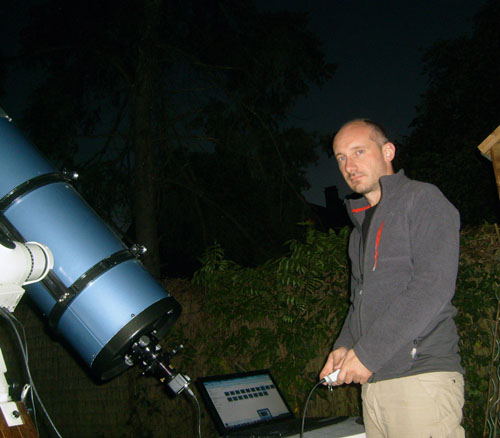
Christophe Pellier
https://www.planetary-astronomy-and-imaging.com
It is now more than twenty years since I first decided to devote all my efforts to observing the planets. I had done the usual things anyone passionate about astronomy did and saw what you could expect to see with the modest equipment I had at the time – a non-motorised, 130mm Vixen Newtonian, and then a 180mm Arcane Newtonian – but what I really wanted was to concentrate on a specific area and do more. At the time, shortly after the mid-1990s, the Internet was then in its rudimentary beginnings and not easily accessible as a source of information: I therefore looked to getting hold of some specialised books on observing the solar system. Among the few books available, was “Introduction to Observing and Photographing the Solar System”, by Thomas Dobbins, Donald Parker and Charles Capen, this got me particularly excited, as it gave me my first inkling as to what I could really see with my telescope. And from that moment on I said to myself I wanted to write a book of my own on the subject!
In the years that followed, I continued to practice with my Arcane, first by drawing, so that I could keep a a record of my observations in some semblance of order; and then I moved into digital photography, thanks to the revolution brought about by the webcams. What a joy it was to obtain my first CCD images, which quickly demonstrated their ability to reveal more details than I ever hope to see through an eyepiece! However, at this time there was always the feeling that observing the planets was only a peripheral activity, almost reserved for beginners, and was no longer of any importance, as for some decades, space probes had been regularly sent to explore the planets.
At the end of 2002, I joined the Planetary Observations Commission of the French Astronomical Society (Société Astronomique de France); together with Gino Farroni, then the head of the Jupiter section, and Daniel Crussaire, head of the Mars section, we at times, felt somewhat alone it must be said! But this did not stop me carrying on, little by little; I began writing articles on observing the planets, particular for the SAF magazine, interspersed by a few lectures at amateur astronomy meetings. I wanted to show to my observing colleagues that there was a lot to see and do on, when it came to the planets! From the other side of the world in Japan, thanks to my first images of Mars taken during the great opposition of 2003, I was warmely welcomed by Masatsugu Minami, editor of “Communications in Mars Observations”. It was also at this time that I had the pleasure to first meet Jean-Jacques Poupeau and Frédéric Burgeot, two passionate amateurs, the first one with optics and mechanics, the second by planetary drawing. You just have to see the amazing quality of the finished items built by Jean-Jacques! As for Fred’s drawings they never cease to amaze me with their impeccable accuracy in the rendering of details and colors.
By the mid-2000s, things began to change. During this period, amateurs began to make important discoveries, notably on Jupiter: the coloration of the oval BA by Christopher Go (in 2006), the cometary impact of 2009 by Anthony Wesley, and the announcement by John Rogers, several months in advance of the actual disappearance of its South Equatorial Belt in 2007 and 2009 … some scientists began to take interest in amateur observations, whose quality improved year after year, as the power of the available digital imaging equipment itself became greater.
At the beginning of 2000, the contrast could not be greater between the quasi-professional cameras intended mainly for deep sky photography, and the small “cobbled together” webcams we used to take images of Mars or Jupiter! But from 2005/2006, some manufacturers began to make dedicated planetary cameras, a sure sign of an increased interest in this type of observation. Finally, in 2006, Marc Delcroix joined the Commission. He soon showed real potential, both for data analysis and for the organization of a team, becoming head of the Saturn section that same year, then in 2009, the president of the Commission itself. He later became a leading observer, participating in scientific work, using the one meter telescope at the Pic du Midi observatory.
The 2010 decade heralded in a new golden age of amateur planetary observation, and everything suggests that it is only the beginning. Old barriers were crossed over the following years: the detection of Uranus’s belts in 2012 (François Emond had been the first to obtained convincing images), those of Neptune in 2013 (Pete Gorczynski), and the storms on Uranus in 2014 (Alexander Obukhov). These amazing advances are not down to mere chance, or simply because our cameras are more efficient: they have also been because amateurs, journalists and scientists, have been keen to make available a tremendous amount of information on the observable activity seen on the planets, on equipment and on techniques, enabling us to better prepare our observations.
It is in this context that the publication of this book is enshrined, to be able pass on to every curious amateur this information, so that they too might fully experience what planetary observation has to offer. Ten years ago, I would have considered writing this book alone: but today, this “discipline” has taken on such a magnitude that I preferred to set up a more ambitious project by calling on other fellow amateur astronomers who have all demonstrated special abilities in planetary observations. Besides Marc, Jean-Jacques and Fred of whom I have already spoken, the team of co-authors also includes: Christian Viladrich, chosen for his talents as an observer but most of all for his extensive skills in instrumental optics and image processing; Jean-Pierre Prost, for the quality of his images but also for his great contribution over recent years on the correction of atmospheric dispersion; and Giuseppe Monachino, who has strong data analysis skills as well for his innovative studies of the planet Venus. Let them introduce themselves.
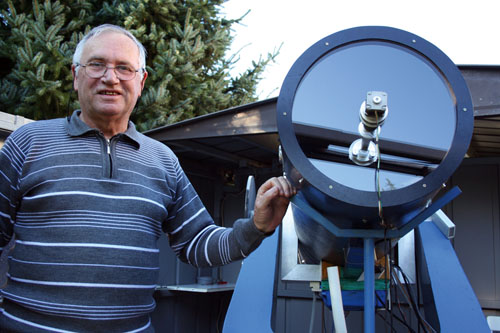
Jean-Jacques Poupeau
I was born in Vendée, France, in January 1945; and as a young teenager I began tinkering with my first astronomical refractor made from an eyeglass and some old vacuum cleaner tubes. Later, when I was nearly 30, I constructed a Newtonian telescope by polishing my first mirror. Shortly afterwards it was a 410mm Cassegrain telescope, which although completed, proved to be too cumbersome and unwieldy and was little used.
After a long absence from astronomy, my interest was reawakened in 2001, on seeing Thierry Legault’s digital images of the planets. I went out and bought my first telescope, a 12-inch Schmidt-Cassegrain to mark my fresh start. Then the craze for grinding glass took over again and became once more the focus of my enthusiasm.
I then created a 350mm Cassegrain with a corrector plate and a set four interchangeable secondary mirrors, a spectroheliograph and a 410mm Newtonian telescope on its own Dobsonian mount, motorized on its two axes. This has recently been transformed into Coude-Cassegrain to be used for planetary observations. The mounts for these instruments are fitted with computer controlled MCMT motors (Multi Telescope Compatible Motors). I have written Delphi utility programs for these instruments (i.e. control, logging, focusing and a motorized filter wheel also built by me). I have also made a GOTO equatorial fork mount for the orange OTA of my C14 Schmidt-Cassegrain that I now use for planetary observations from Vendée. In 2010, I was awarded the Julien Saget prize of the French Astronomical Society in recognition of my many planetary images.
On a professional level, I hold a diploma in Chemical Engineering from the Senior High School of Industrial Chemistry at Lyon. Initially, my career was in the chemical industry and afterwards I worked at ONERA (Office National d’Etudes et Recherches Aérospatiales) and then at the ECA (Defence & Security) Group up until my retirement. There I specialized in mass spectrometry.
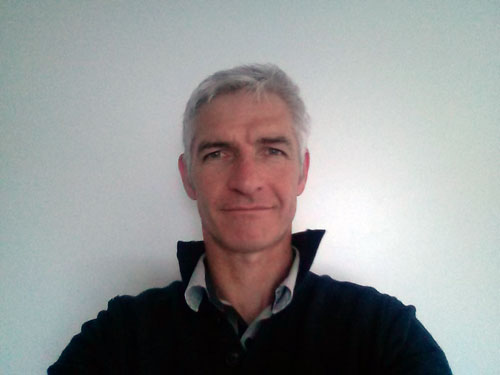
Jean-Pierre Prost
https://www.astrosurf.com/prostjp
Born near Paris in January 1967, I am an engineer by profession working in the aerospace sector for Thales Alenia Space at their headquarters in Cannes La Bocca.
From a very young age everything about space excited me, the planets, the stars, in fact anything that lay beyond our atmosphere. After a certain amount of “slick” negotiation with my parents I managed to obtain my first telescope, a 70mm refractor, when I was ten. My “firstlight” through an eyepiece was of Saturn with its rings clearly visible, it was an unforgettable experience. From that moment on, the astronomy bug took hold and remained, through my teenage years.
This passion became my profession. After completing my studies in space aeronautics, I then worked for various large companies in the sector. My professional work and my “expanding” family, somewhat eclipsed the practice of astronomy. But the bug, returned with the exceptional solar eclipse of 1999: I remembered my first sight of Saturn and my interest was reawakened.
This time, experience came with age, I decided to take matters more seriously and acquired a fully computerised 127mm Celestron Nexstar 5; equipment, then considered the lazy person’s telescope. Yet, this telescope allowed me to rediscover the splendours of the sky and all the easier thanks to its GOTO system. Soon my interest moved into imaging, and especially the planetary imaging. But for this I needed more suitable equipment, so I sold everything for a 102mm FS102 Takahashi refractor, then I replaced it with a 212mm Cassegrain also made by Takahashi, then another Takahashi – a 250mm Mewlon Dall-Kirkham; and finally a 356mm Celestron C14, all in the space of eleven years.
Aperture fever took hold; this allowed me to continuously improve the quality and the level of resolution of my images; also benefitting from the frequent advice given to me by other members of the Planetary Commission of the SAF or on the Astrosurf forum.
In my quest for perfection, I have always sought to improve my OTAs, by removing their inevitable flaws. The C14 is the one which has been modified most of all and is now optimised for planetary imaging: the required changes are the subject of a separate chapter of this book. Based on the same reasoning, I use best quality accessories, including an atmospheric dispersion corrector, whose workings I studied and analysed, a piece of equipment which proved to be essential in obtaining detailed images.
Since 2005, I have been a member of the Thales Alenia Space (Astrospace) Astronomy Club, which a few years ago built its own observatory on the site of the Cote d’Azur Observatory at Calern. This site is renowned for the quality of its seeing conditions. Situated approximately half an hour from my home, it is the site where I am privileged to be able to make observations and also to conduct imaging sessions, using either the club’s or my own personal equipment.
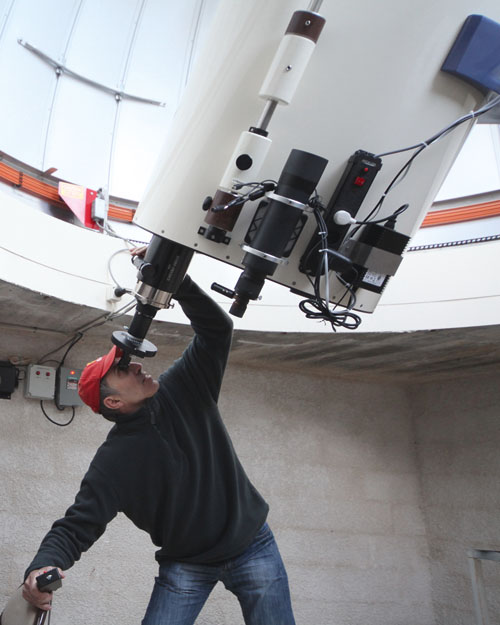
Christian Viladrich
https://astrosurf.com/viladrich
I became interested in astronomy and astronomical photography more than 40 years ago. My first photographs of the sky were taken in 1974 using a Lubitel 66 camera, of the very disappointing comet Kohoutek, which had been hailed as the “Comet of the Century”!
Fortunately, the spectacular comets West, Hyakutake and Hale Bopp made up for this wasted effort. This was the time of silver based emulsion photography, the darkroom and gas hypersensitization. I became interested in all types of imaging (deep sky, comets, high resolution, etc.), although in recent years I have begun to concentrate more and more on high resolution imaging (lunar, solar and planetary), always trying to push out the envelope by trying to better understand the optical and mechanical possibilities of instruments, the performance of the sensors and the image processing software.
My passion for solar eclipses goes back to 1974, when in a journal I saw an awesome image of the solar corona taken with a radial filter by Serge Koutchmy of the Paris Institute of Astrophysics. Much later I was fortunate to participate under his direction in a dozen of missions at professional solar observatories (Sacramento Peak Observatory in USA, Pic du Midi in France, Tabriz Observatory in Iran and in Angola), and a number of solar eclipse expeditions, including one from an airplane. This gave me the opportunity to make what was probably one of the very first amateur detection of the “earthshine” during a solar eclipse (in February 1998), which was followed in 2000 by the award of the Julien Saget prize of the French Astronomical Society. In 2006, the Association of Lunar and Planetary Observers awarded me a “certificate” for my Calcium K solar images. I also had the chance to participate in a planetary observing mission to the famous 1m telescope at at the Pic du Midi observatory (France) under the direction of François Colas of the Paris Observatory.
Finally, I have always taken great pleasure in passing on astronomical imaging techniques to others. I have for more than 15 years led a photographic workshop at the Astronomy Festival at Haute Maurienne (France), and am one of the team leaders at the “High Resolution” course organised by the french Astro-Images-Processing association (AIP).
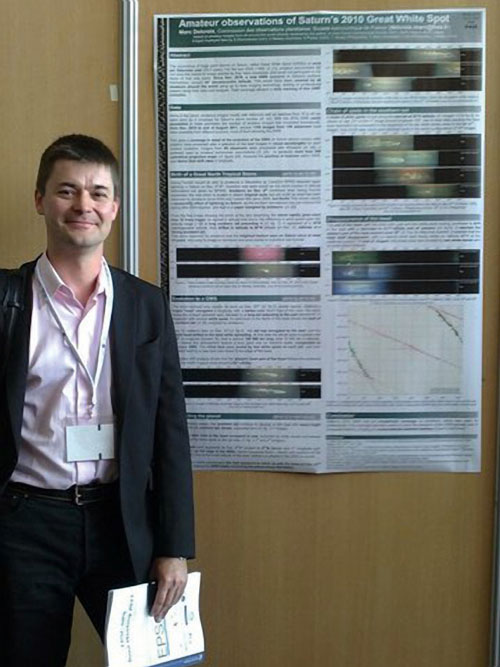
Marc Delcroix
https://astrosurf.com/delcroix
I was born in 1970, in couple with two children and have been passionate about astronomy ever since my childhood: my father used to read to me extracts from scientific magazines, but it was their images of the planets, from the Pioneer and Voyager probes, which made me dream. After finishing my scientific studies (astronomy being the “queen of the sciences”, according to English polymath, William Whewell), I became an aeronautical engineer and am at present employed as an IT Director.
As a teenager I touched on amateur astronomical observations using a small telescope, but it was only in 2006 that I became a serious planetary observer with a 254mm Schmidt Cassegrain and a webcam, which I used from the suburbs of Toulouse (I have since changed it for 320mm Skyvision Dobsonian on an equatorial wedge and the next generation of planetary cameras). I have the unforgettable memory of my first view of Saturn through the eyepiece of this telescope, a deep and inexplicable emotion. I was able to rapidly make progress with my observations thanks to the Internet and the amateur community; but I soon realised that I wanted to do more than just take beautiful images but understand what I was actually imaging.
Being in contact with Christophe Pellier, I joined the Commission of Planetary Observations of the Société Astronomique de France (of which I later became president). I took up the study of Saturn (Mars and Jupiter was then abundantly observed) which seemed to me simpler considering the few details which can be seen. However, in 2007 I started collaborating with professionals, identifying the sources of thunderstorms observed by the radio instruments aboard the Cassini probe, not only using my images but also those of the entire amateur community. I was also able to be at the centre of things during the great storm of 2010 monitoring its progress on images from the outset and collaborating with the great names in the world of planetary astronomy, through my participation in the writing of articles for journals.
I also initiated in collaboration with professionals a project for the detection of planetary impacts thanks to the development of some software designed to be as simple as possible, to be used by amateurs to study their videos, in order to finally determine the frequency of detectable planetary impacts.
My current interest is the detection of bright regions on Neptune (first seen on amateur images in 2013) and the storms on Uranus (detected by amateur astronomers in 2014).
I am also lucky to be able to image the planets from Pic du Midi, using its legendary one metre telescope which has done so much for planetary science, through which I was able to rediscover with a certain amount of emotion the beauty of Saturn and its magnificent rings. I share this passion with others by writing for amateur magazines and speaking at meetings of amateur astronomers. Finally, I seek to promote the work of amateurs with professionals, by actively encouraging collaborations between each other. In particular, through the lively sessions on pro-am collaboration which take place at the annual European Planetary Science Congress organized by Europlanet.
These exciting studies of the planets and my collaborations with professionals are for me, like a childhood dream, one which I never thought could possibly come true.
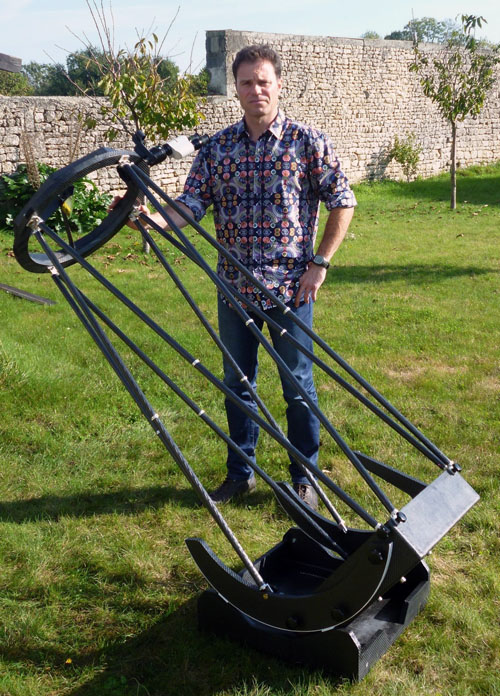
Fred Burgeot
Born in January 1974 in Nantes, France, I am a professor of mathematics and the father of two boys. At school, mathematics and the sciences captivated me, but it was not until I was twenty one that astronomy began to interest me. Reading about the planets of the solar system particularly fascinated me: I discovered that these other worlds offered such different appearances and behaved in ways which were beyond what I could possibly imagine. The desire to observe them with my own eyes became very strong, so much so that I acquired a telescope, only 80mm in aperture, but with it I immediately began to look at Jupiter and Mars. I could see their largest surface details, whose appearance was typical of what one might expect when seen through a small telescope; but I was somewhat surprised to notice that after half an hour or so I could detect their rotation and after a longer period, actual changes in their appearance. These changes gave me the feeling that I was really looking at other living worlds, this overwhelmed me and motivated me to follow these “living” planets over the coming years. Given my taste for drawing, I recorded my observations by sketching them, a little bit like a naturalist. I hesitantly traced some planetary maps which brought together a season’s observations. In time, my means of observation changed; with larger instruments and greater observing experience, the formations I could see became more numerous and ever more detailed. Even though it is now almost twenty years after I made my first drawing of a planet, I still do with a pleasure that never wavers.
I am one of the six co-authors of the book “Astrodessin, observation and drawing in astronomy”, whose purpose (among others) is to share methods and observing tips. With the same objective in mind, I wrote a few articles for astronomy magazines as well as giving talks at amateur astronomy meetings.
Away from astronomy, I am an active sportsman: basketball, boomerang throwing and running.
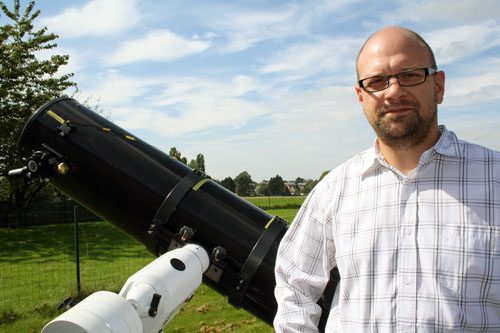
Giuseppe Monachino
I was born on the 25th October 1975 and spent my childhood in central Belgium; astronomy has always fascinated me from an early age. My parents’ home was unfortunately not situated in one of those rare places in Belgium where the sky is dark; that is when it is not covered by cloud, of course. This naturally limited my first observations, during the summer of 1989; I used a conventional 60mm refractor; to study the Moon and planets. My greatest joy was when I discovered planetary astronomy, marked by two major events which I closely followed: the disappearance of Jupiter’s SEB and the Voyager 2 flyby of Neptune. It was also at this time that I became interested in ephemerides and the history of astronomical observations.
A few months later, I had the opportunity to use my school’s orange Celestron C8 and by altering my curriculum, I took photography lessons instead, where I learnt the basics of developing silver emulsion films, which led to my first astronomical images, taken when I was sixteen.
After a brief interlude when I obtained my engineering diploma in industrial chemistry, I returned to astronomy in the early 2000’s, by writing a few popular articles and participating in the activities of the University of Mons’s Astronomy Club, where I organised some light hearted discussions on observing the moon and planets, during which time the emphasis was placed on the link between looking at a planet through an eyepiece and understanding the workings of the solar system itself.
Although my interest extends to observing and studying all the planets of the solar system, Venus is my special favourite. In September 2012 I was fortunate enough to conduct a series of observations to study the dynamics of its atmosphere at the Saint Veran Observatory at Hautes-Alps, France, thanks to the auspices of the AstroQueyras association. The promising results obtained during this trip were presented in September 2013 at the European Planetary Science Congress in London. I am a member of the Astronomical Society of France, and it is my pleasure to read about and participate in the meetings of the Planetary Commission of the SAF, whose success, and the quality of the images and reports exchanged, shows that the future of amateur studies of the planets is destined to be a bright one.
I am married and the father of two daughters, I am also passionate about the underwater world and in particular by the marine ecology of the Mediterranean sea.
